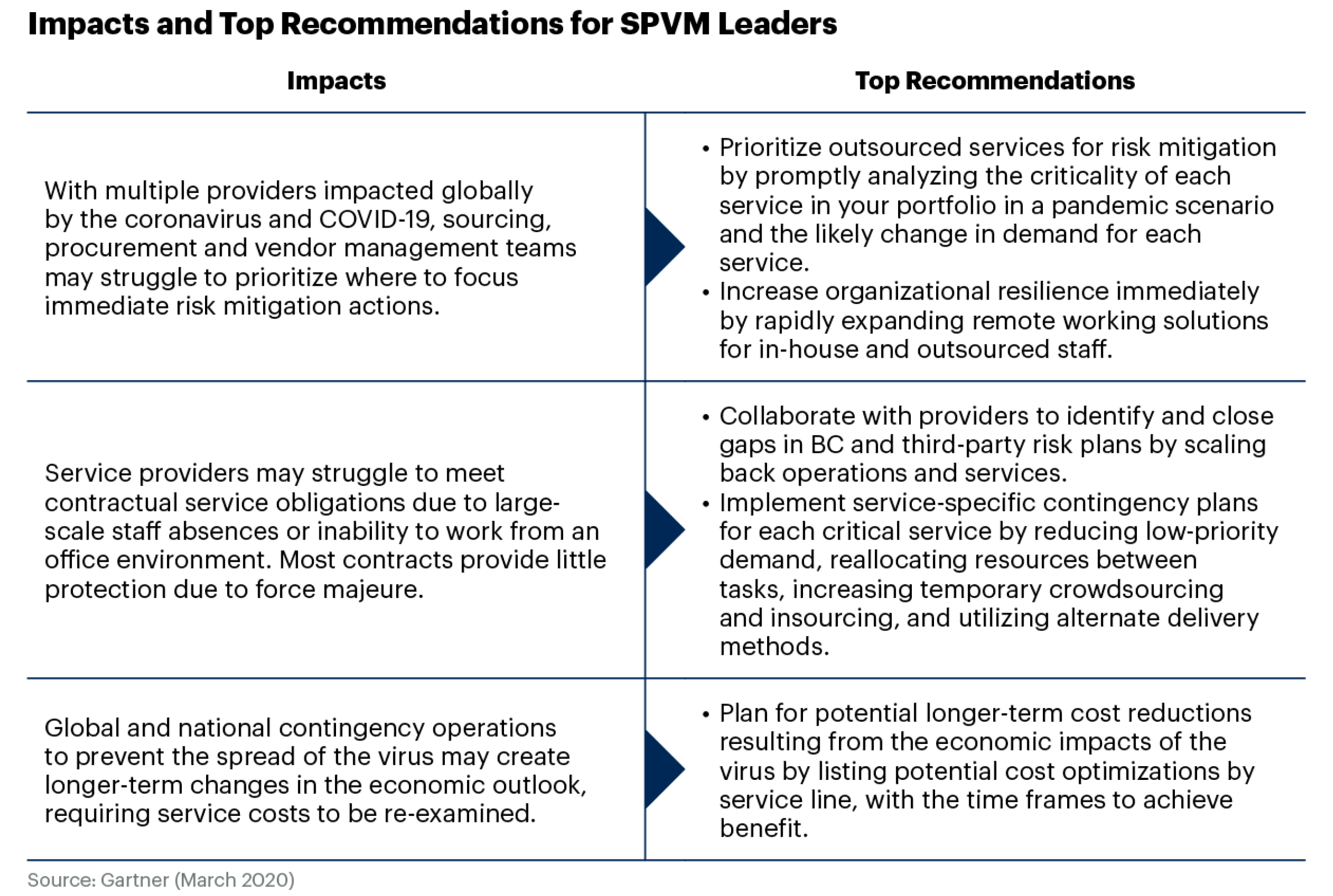
Practical Advice for Managing Outsourced Service Provider Impacts During a Pandemic
To say we live in challenging times is an understatement. No IT organization is immune to the overwhelming disruption COVID-19 has caused to business and operations, including those at enterprises that utilize outsourced services and those within the service providers that deliver those services.
In our last blog post, “Improve Resilience During a Pandemic with an IT Service Continuity Plan,” we looked at the short- and long-term implications of the current pandemic from the IT team’s perspective. This time we’ll look at the situation from the end-user’s perspective and explore actions they can take to manage outsourced service providers and mitigate the impact of the pandemic on their operations.
How to Manage Outsourced Service Providers: Actionable Steps
Leading research firm Gartner recently published guidance for end-customers that provides an in-depth study on this exact topic. The infographic “Advice for I&O Leaders During a Global Pandemic” summarizes the report and describes immediate steps that sourcing, procurement and vendor management leaders must take to minimize the impact any issues their service providers may encounter as a result of COVID-19 have on their business.

Let’s break down the five actions summarized in the report. The figure above shows Gartner’s three key multi-faceted impacts and the five recommendations.
Impact #1: IT Organizations Struggle to Prioritize Risk Mitigation Efforts
Most end-customers depend on multiple service providers to deliver the capabilities their critical business services require to be operational. In some cases, these services are delivered from different geographical locations, each currently experiencing its own specific difficulties related to the crisis.
The challenge end-customers face is to prioritize where to focus risk mitigation efforts and to adapt as the scenario evolves. The first two actions apply directly to addressing this issue:
- Action 1 – Prioritize outsourced services for risk mitigation Once you have established your business continuity team, then identify the outsourced service providers that are behind your most critical business processes. Next, prioritize those providers in terms of their impact to your business by, for instance, stack ranking them on a service-level basis. For each service, try and understand the foreseeable change in demand. The goal here is to build the ability to react rapidly, and to do so in a prioritized fashion by identifying the criticality of outsourced processes.
- Action 2 – Increase remote working capabilities With social distancing and curfews on non-essential travel, there is a corresponding increase in the need to work remotely. This means that IT organizations need to continue to put in place operational resilience to facilitate remote working solutions for both employees and outsourced staff. Key considerations include managing network bandwidth, the availability of equipment, the expanded use of workplace collaboration tools and the support, security and testing policies to make these efforts resilient.
Impact #2: Service Providers Struggle to Meet Contractual Obligations
The COVID-19 outbreak has led to increased remote working and staff absenteeism, and service providers experiencing these realities firsthand may be struggling to meet contractual obligations as a result. Here are two crucial actions that end-customers can take to address the issue.
- Action 3 – Work with providers on contingency plans Every service provider has a business continuity plan in place. However, if the services they provide begin to decline, end-customers need to have a plan in place to mitigate the risk. This includes analyzing the contractual terms, understanding where they stand from the provider’s perspective, examining the provider’s business continuity plan and agreeing on additional mitigations. All these activities involve working directly with service providers in an honest and collaborative manner.
- Action 4 – Develop contingency plans for critical services At some point, the likelihood of a critical service going down becomes a reality. The service provider simply cannot deliver. While they may be able to eventually recover, the short-term impact to your business can be huge. In order to hedge against this risk, end-customers need to build contingency plans for outsourced critical services in order to provide business continuity. It is essential that end-customers explore alternative solutions and look for viable options to replace capabilities.
Impact #3: Longer-Term Changes in Economic Outlook
In the earlier stages of the pandemic, the longer-term effects of the recovery are not completely understood. Of course, it’s universally recognized that there will be a negative impact to the global economy and to business revenue. So how can enterprises plan for this uncertainty?
- Action 5 – Plan for longer-term cost reductions To reduce ongoing costs in services, take advantage of this opportunity to examine all facets of the conduct of business. For instance, service portfolios need to be rationalized, labor resources need to be optimized, service-level agreements need to be amended to reflect reduced demand, and flexible provisioning options need to be determined.
Don’t leave any stones unturned, ensure you are managing outsourced service providers effectively during a time of crisis. The future of your overall business depends on it.
To learn more about how to mitigate the effect of pandemics on your operations, download the infographic “Advice for I&O Leaders During a Global Pandemic.”